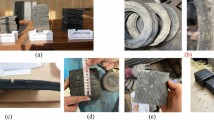Abstract
This paper focuses on the experimental studies conducted on the development of no-cost seismic base isolation pads using scrap automobile tire pads (STP). The mechanical and dynamic properties of STP specimens made from different tire brands, with different number of layers, and orientations are evaluated experimentally. The tests are conducted using (a) axial compression tests, (b) lumped mass small displacement free vibration, and (c) large displacement (inclined plate and reverse-cyclic) static shear tests. The results of these STP tests are compared among themselves and against a commercially available laminated rubber bearing specimen. A general relationship has been proposed which formulates the stiffness differences between the two principal directions of rectangular pads. The paper includes three hypothetical design applications for the use of STPs.
STPs are prepared by placing 18 cm × 20 cm cut tread sections layers of car tires on top each other. Larger size STPs can also be formed by placing longer strips of tread sections (integer multiples of tread width) side by side in alternating direction layers or using a woven structure. Test results have shown that the friction between tire layers is sufficient to keep layers intact. Although STP application cannot eliminate foundation-basement structural requirements, it presents advantages such as low-technology no-cost pad, weight reduction, ease of handling, simple shear stiffness adjustment by changing the number of layers, and environmental benefits by recycling scrap tires.















Similar content being viewed by others
References
Kelly JM (1986) Aseismic base isolation: review and bibliography. Soil Dyn Earthq Eng 5:202–216
Naeim F, Kelly JM (1999) Design of seismic isolated structures, John Wiley & Sons
Jangid RS, Datta TK (1995) Seismic behavior of base-isolated buildings: a state-of-the-art review. Struct Buildings 110:186–203
Kelly TE (2001) Base isolation of structures: Holmes Consulting Group Ltd
Walters Forensic Engineering (2006) Skidmark analysis & braking http://www.waltersforensic.com/articles/accident_reconstruction/vol1-no8.htm. Cited 01 Dec 2006
Glenn Elert (1998–2006) The Physics Hypertextbook http://hypertextbook.com/physics/mechanics/friction/. Cited 01 Dec 2006
Chopra AK (2001) Dynamics of structures. Upper Saddle River, NJ Prentice-Hall
Butterworth J, Lee JH, Davidson B (2004) Experimental determination of modal damping from full scale testing. In: Proceeding of the 13th World Conference on Earthquake Engineering. No. 310
Abe M, Yoshida J, Fujino Y (2004) Multiaxial behaviors of laminated rubber bearings and their modeling. I: experimental study. ASCE J Struct Eng 130(8):1119–1132
Topkaya C (2004) Analysis of specimen size effects in inclined compression test on laminated elastomeric bearings. Eng Struct 26:1071–1080
Topkaya C, Yura JA (2002) Test method for determining the shear modulus of elastomer bearings. ASCE J Struct Eng 128(6):797–805
Kelly JM, Takhirov SM (2002) Analytical and experimental study of fiber-reinforced strip isolators. PEER Report 2002/11, Earthquake Engineering Research Center, University of California, Berkeley
Kelly JM (1992) The implementation of base isolation in the United States. Report UCB/EERC-92/13, Earthquake Engineering Research Center, University of California, Berkeley
Ozden B (2006) Low-cost seismic base isolation using scrap tire pads (STP). Dissertation, Department of Civil Engineering, Middle East Technical University, Ankara, Turkey
Uniform Building Code UBC (1997) International conference on building officials
Ministry of Public Works and Settlement (1998) Specification for structures to be built in disaster areas; Part III – earthquake disaster prevention. Government of Republic of Turkey
Acknowledgements
This study is a part of “Seismic Performance Improvement of Masonry Houses Project”, which is supported by The World Bank (DM2003 SPIM-1451) and TUBITAK (MAG-104I011). Both institutions are gratefully acknowledged by the authors. Special thanks are extended to Mr. İbrahim Sirer at The World Bank, Mr. Huseyin Akova at TUBITAK, FNSS Savunma Sistemleri A.Ş, and Middle East Technical University, Medical and Health Services, X-Ray office.
Author information
Authors and Affiliations
Corresponding author
Rights and permissions
About this article
Cite this article
Turer, A., Özden, B. Seismic base isolation using low-cost Scrap Tire Pads (STP). Mater Struct 41, 891–908 (2008). https://doi.org/10.1617/s11527-007-9292-3
Received:
Accepted:
Published:
Issue Date:
DOI: https://doi.org/10.1617/s11527-007-9292-3




